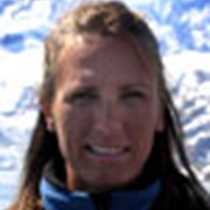Glacier Bay National Park and Preserve
Early this morning we entered Glacier Bay which two hundred years ago we couldn’t have because a 200 foot wall of ice blocked the entrance. That is exactly what happened to Captain Vancouver when he was charting this area in 1794; the bay was only a 5 mile indentation. Today we can travel 60 miles into what has become one of the world’s best studied ecosystems.
At 5am we docked at the park’s headquarters in Bartlett Cove to pick up ranger Janene, and by 7am we were looking at a raft of about 200 sea otters resting, rolling, preening, eating and swimming around in the kelp bed around the tiny island of Boulder. Mergansers floated between the kelp bed and the rocky beach of the island. At 8am we reached the Marble Islands where we saw and heard Steller sea lions, cormorants, gulls, oyster catchers, puffins, pigeon guillemots, and murres. On these islands most of these birds are nesting. We proceeded up the bay and took a turn into Tidal Inlet where we spotted a couple of bald eagles perched on driftwood near the shoreline, and rafts of surf scoters floating around. Upon looking high up on the mountains, we spotted 12 mountain goats feeding in the greenery. We all kept looking for bears, but to no avail. Then, at around 10:40am, Janene made the announcement that bears had been detected. There were 4 brown bears, a sow and her three cubs, walking in the intertidal zone. For the next hour we followed the life of this family as they rolled barnacle covered rocks in search of food.
At 1:45pm we rounded Jaw Point where we got the first look at John’s Hopkins glacier at a distance of 5 miles away. There was a sea of iceberg ahead of us. After slaloming through the inlet, we reached the face of the glacier and noticed hundreds of harbor seals plopped on the icebergs, perhaps resting. For an hour, we awed at the features of the glacier: the many medial moraines indicating the tributaries that joined up high in the mountains, the jagged edge of the face, black striations, the towering peaks, the intense blue hue and several calvings of ice. How insignificant this place makes us feel…
Next, we sailed past Lamplugh and Reid glaciers on our way down the bay back to the headquarters… so we thought. After getting all warm and cozy in the lounge and cabins, the call came from the bridge: Orcas! It was 5:30pm. We all flew up on deck to observe a pod of 6 transient orcas, including one small calf. Except they were going the wrong way, up the bay. We stayed with them for a half hour until we absolutely had to turn around and cruise down the bay. What a day!
Early this morning we entered Glacier Bay which two hundred years ago we couldn’t have because a 200 foot wall of ice blocked the entrance. That is exactly what happened to Captain Vancouver when he was charting this area in 1794; the bay was only a 5 mile indentation. Today we can travel 60 miles into what has become one of the world’s best studied ecosystems.
At 5am we docked at the park’s headquarters in Bartlett Cove to pick up ranger Janene, and by 7am we were looking at a raft of about 200 sea otters resting, rolling, preening, eating and swimming around in the kelp bed around the tiny island of Boulder. Mergansers floated between the kelp bed and the rocky beach of the island. At 8am we reached the Marble Islands where we saw and heard Steller sea lions, cormorants, gulls, oyster catchers, puffins, pigeon guillemots, and murres. On these islands most of these birds are nesting. We proceeded up the bay and took a turn into Tidal Inlet where we spotted a couple of bald eagles perched on driftwood near the shoreline, and rafts of surf scoters floating around. Upon looking high up on the mountains, we spotted 12 mountain goats feeding in the greenery. We all kept looking for bears, but to no avail. Then, at around 10:40am, Janene made the announcement that bears had been detected. There were 4 brown bears, a sow and her three cubs, walking in the intertidal zone. For the next hour we followed the life of this family as they rolled barnacle covered rocks in search of food.
At 1:45pm we rounded Jaw Point where we got the first look at John’s Hopkins glacier at a distance of 5 miles away. There was a sea of iceberg ahead of us. After slaloming through the inlet, we reached the face of the glacier and noticed hundreds of harbor seals plopped on the icebergs, perhaps resting. For an hour, we awed at the features of the glacier: the many medial moraines indicating the tributaries that joined up high in the mountains, the jagged edge of the face, black striations, the towering peaks, the intense blue hue and several calvings of ice. How insignificant this place makes us feel…
Next, we sailed past Lamplugh and Reid glaciers on our way down the bay back to the headquarters… so we thought. After getting all warm and cozy in the lounge and cabins, the call came from the bridge: Orcas! It was 5:30pm. We all flew up on deck to observe a pod of 6 transient orcas, including one small calf. Except they were going the wrong way, up the bay. We stayed with them for a half hour until we absolutely had to turn around and cruise down the bay. What a day!




